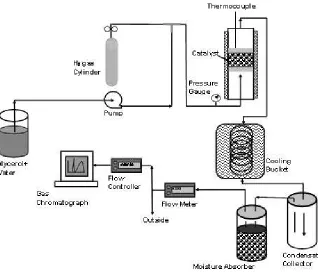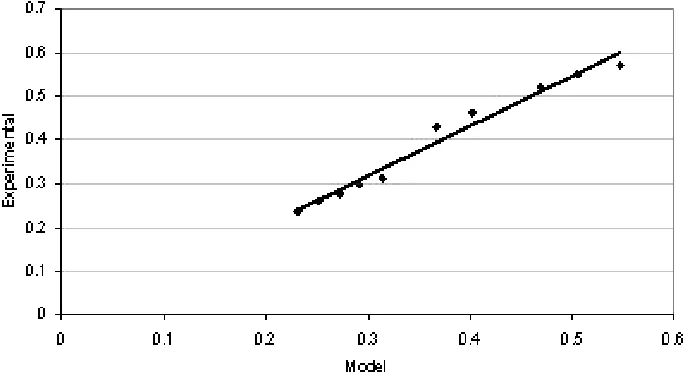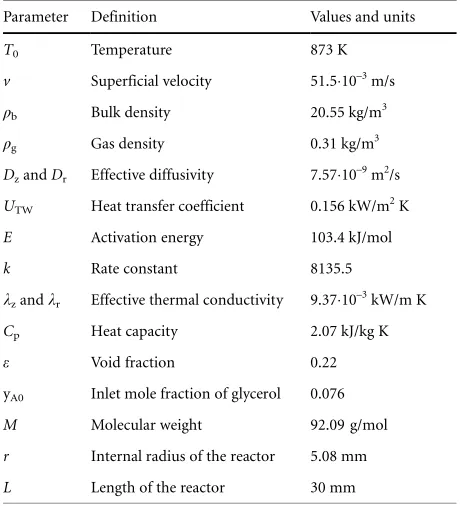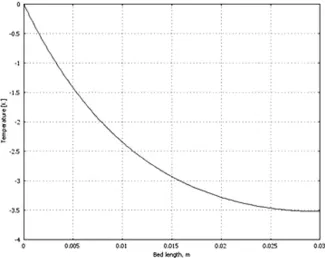Research Article
Kinetics and Reactor Modeling of Hydrogen
Production from Glycerol via Steam
Reforming Process over Ni/CeO
2
Catalysts
As a result of skyrocketing prices, environmental concerns and depletion
asso-ciated with fossil fuels, renewable fuels are becoming attractive alternatives. In
this respect, the demand for biodiesel has increased tremendously in recent years.
Increased production of biodiesel has resulted in a glut of glycerol that has
re-duced the demand for this once valuable commodity. Consequently, finding
alter-native uses for glycerol is a timely proposition. One alteralter-native is producing
renewable hydrogen from this cheap commodity. Only a handful of studies have
been conducted on producing hydrogen from glycerol. Previous studies have
mainly focused on finding effective catalysts for glycerol steam reforming. This
paper extends previous knowledge by presenting kinetic parameters in relation to
glycerol steam reforming over Ni/CeO
2and a reactor modeling. The study found
that the activation energy and the reaction order for the glycerol steam reforming
reaction over Ni/CeO
2catalyst were 103.4 kJ/mol and 0.233, respectively.
Keywords:Biodiesel, Glycerol, Hydrogen, Nickel, Steam reforming
Received:September 12, 2008;revised:October 27, 2008;accepted:December 03, 2008
DOI:10.1002/ceat.200800462
1
Introduction
In recent years, “hydrogen economy” has received much atten-tion around the world. As a result, extensive research has been performed on finding sustainable sources for hydrogen. Bio-mass is an intriguing candidate for producing hydrogen. Our study focused on generating hydrogen from glycerol, a bypro-duct of biodiesel processing. In earlier studies, we tested sever-al metsever-al catsever-alysts [1] and ansever-alyzed the effects of different sup-ports [2] on hydrogen production from glycerol. The study found that CeO2-supported Ni catalysts performed best
com-pared to MgO- and TiO2-supported catalysts in the steam
reforming reaction. Other groups also studied hydrogen pro-duction from glycerol via steam reforming [3–5], autothermal [6, 7] and aqueous-phase reforming processes [8]. Most of these studies focused on catalyst performance testing. How-ever, kinetics data were limited [9]. This study presents the kinetics of the glycerol steam reforming process and reactor
modeling over a Ni-based CeO2-supported catalyst. The
over-all reaction of the glycerol steam reforming process can be pre-sented as in Eq. (1):
C3H8O3+ 3 H2O→7 H2+ 3 CO2 (1)
2
Methodology
2.1 Reaction Rate Expression
A power law model has previously been used to express the reaction kinetics for methanol [10] and ethanol [11, 12] steam reforming processes. Consequently, in this study, we used the power law model to fit experimental data. The model is in the form as given in Eq. (2):
wherenrepresents the reaction order with respect to glycerol.
EandTdenote the activation energy and the reaction temper-ature, respectively.k0represents the reaction constant and R is
the universal gas constant. The given form of the rate model does not include the water concentration because water was present in excess compared to the concentration of glycerol. It Sushil Adhikari1
2Department of Biological and
Agricultural Engineering, Texas
Correspondence: Dr. Sandun D. Fernando ([email protected]), Department of Biological and Agricultural Engineering. Texas A & M University, College Station, TX 77843, USA.
should be noted that a similar model was used for ethanol steam reforming in a previous work [12].
2.2 Kinetics Data
The experimental procedure outlined by Idem and Bakhshi [10] was followed to collect intrinsic kinetics data for the reac-tion. Mass transfer limitations were minimized by selecting an appropriate particle size range. Several catalyst particle size ranges were tested to determine whether the reaction was mass transfer limited. No changes in glycerol conversion were found with the increase in the particles from 60–70 to 80–100 U.S. sieve size. Consequently, particles of 60–80 range were used for the kinetics study. Film diffusion in the reaction system was also minimized by selecting suitable flow rates, and there was no significant change in glycerol conversion when the feed flow rate increased from 0.25 to 0.35 mL/min. Consequently, the feed flow rates that were used in our experiment ranged from 0.25 to 0.35 mL/min. The plug flow conditions in the reactor were also maintained by avoiding back mixing and to mini-mize channeling. The conditions to avoid back mixing and channeling are (i) ratio of the internal diameter of the tube to the catalyst particle size (d/Dp) >10 and (ii) ratio of the
cata-lyst bed to the catacata-lyst particle size (L/Dp) >5013. In this work,
d/DpandL/Dpwere 49.1 and 142, respectively, and these
val-ues ensured plug flow conditions in the reactor. To maintain isothermal conditions in the reactor, the catalysts were mixed with inert materials (fused silica). The amount of inert materi-als was varied to maintain a pre-selected catalyst bed length. Intrinsic kinetics data for this study were collected at 873 and 923 K.
2.3 Catalyst Preparation
Nickel catalysts were prepared over a CeO2 support (Nanoscale Materials,
Manhattan, KS, USA). Catalysts were prepared by the incipient wetness tech-nique using nickel nitrate hexahydrate [Ni(NO3)26 H2O] purchased from
Sigma-Aldrich (St. Louis, MO, USA). Catalysts were dried at 383 K for 12 h and calcined at 773 K for 6 h in air. The furnace temperatures were ramped at 10 K/min for catalyst drying and cal-cination. After drying, the catalyst samples were sieved for an appropriate size and selected size ranges were used for analysis.
2.4 Catalyst Performance Testing
All experiments were carried out in a tubular furnace that could reach tem-peratures up to 1373 K. Glycerol and
water were mixed in a separate container at pre-selected molar ratios prior to the experiments. The mixture was then intro-duced into the tubular reactor using a high-pressure liquid chromatography (HPLC) pump (LC-20AT; Shimadzu Scientif-ic Instrument, Columbia, MD, USA). Catalysts were diluted with fused silica of similar size to maintain an isothermal con-dition, and the mixture of catalyst and fused silica was placed inside a reactor using quartz wool. The reactor was made of quartz with 0.5 inch outer diameter and 0.054 inch wall thick-ness and was purchased from Technical Glass Products (Pai-nesville Twp., OH, USA). Prior to the experiment, the catalysts were reduced by sending H2gas (50 mL/min) for 1 h at 973 K.
The output gas stream from the reactor was cooled using crushed ice and water. Unreacted water, glycerol, and other liq-uids that formed during the reaction were collected at room temperature by condensing. The condensate was used to ana-lyze glycerol conversion. Fig. 1 illustrates the glycerol steam re-forming process schematically. Hydrogen gas (Fig. 1) was used only during the catalyst reduction process. An HPLC system (1200; Agilent Technologies Inc., Palo Alto, CA, USA) was used to analyze glycerol conversion with a Zorbax carbo-hydrate column (4.6 × 150 mm, 5lm) using a mixture of ace-tonitrile and water as the mobile phase. Outlet gases were passed through a moisture trap before sending into a gas chro-matograph unit (GC6890; Agilent Technologies Inc.). The hy-drogen content in the gas mixture was analyzed by a thermal conductivity detector with an HP-Plot molecular sieve col-umn. Concentrations of carbon monoxide (CO), methane (CH4), carbon dioxide (CO2), ethane (C2H6), and ethylene
(C2H4) were analyzed by a flame ionization detector with an
HP-Plot Q column. Altogether, six gases including H2 were
analyzed.
2.5 Numerical Modeling
The numerical model for a packed-bed tubular reactor was de-veloped based on the steady-state mass and energy balance. The model was based on the following assumptions: (i) pseu-do-homogeneous chemical phase, (ii) constant density, (iii) constant velocity, (iv) constant wall temperature, (v) negligible pressure drop, (vi) gas ideal law. The mathematical model could be presented in the cylindrical coordinates, and the mass and energy balance for species i can be written as follows [14, 15]:
whereDzand Drdenote the effective diffusivity in axial and
radial directions, respectively.krandkzdenote the radial and axial effective thermal conductivity, respectively.vdenotes ve-locity in the axial direction,Ciis the concentration of species i, qbdenotes the catalyst bed density,qgdenotes the gas density,
Cp denotes the heat capacity,ridenotes the reaction rate for
speciesi,Tdenotes the temperature, andDHdenotes the heat of reaction.
The initial and boundary conditions for the steady-state en-ergy and mass balance equations were as follows:
Ci r;0 C
whereUTWdenotes the overall heat transfer coefficient of the
tube and the superscript 0 denotes the inlet condition.
3
Results and Discussion
3.1 Activation Energy and Reaction Order
Glycerol conversion in this study was defined as given below:
XGlycerol in Glycerol out
Glycerol in (8)
A design equation for the plug flow reactor was used for data analysis and the rate expression was expressed in the dif-ferential form as shown below [12]:
ra
dX
d W
FA0
(9)
whereWandFA0denote weight of the catalyst and feed flow
rate, respectively.
To obtain the experimental reaction rates, slopes were taken as various points of Xvs.W/FA0curves within the range of
the operation conditions. Tab. 1 shows the kinetics data and the experimental reaction rates as described in Eq. (9). The equilibrium constant (Kp) was calculated as given in
Eq. (10):
lnKp
DG
RT (10)
whereDGis the Gibbs energy change of reaction, R is the uni-versal gas constant andTis the absolute temperature of reac-tion.
The values of activation energy and reaction order based on the power model (Eq. (2)) were estimated with nonlinear re-gression analysis using the Marquardt algorithm using SAS 9.1 software [16]. The activation energy and the reaction order were found to be 103.4 kJ/mol and 0.233, respectively. The re-action constant was found to be 8135.5 kmol0.767/(s0.767kgcat). Simonetti et al. [9] had reported activation energies of 60–90 kJ/mol for Pt and Pt-Re catalysts and the reaction order of 0.2 for glycerol. The activation energy is slightly higher and the reaction order is close to the findings of Simonetti et al. [9]. Fig. 2 depicts the comparison of measured and predicted rates using Eq. (8). Some data points were not fitted well and it appears that the data represent two regimes. However, when the data obtained at 823 K were tried to fit in Eq. (2), the mod-el did not converge. This might be because of a few data points. However, if all the data (at 873 and 923 K) were used to fit in Eq. (2), the model did converge. Because of the sim-plicity of the rate expression and because the results were close to the published data, the model and the values for activation energy and reaction order have been accepted.
3.2 Model Prediction
Reactor modeling was performed using COMSOL®software. Tab. 2 gives the parameters and their values used for predicting the model. The data for gas density and the overall heat trans-fer coefficient were taken from Akande et al. [12]. The data for heat capacity and effective thermal conductivity were taken from Akpan et al. [17]. The data for effective diffusivity was calculated using the Gilliland equation [18].
Table 1.Experimental reaction rates and intrinsic kinetics data for glycerol steam reforming.
Run Rate of reaction [kmolglycerol/kgcats]
CA [kmol/s]
CB [kmol/s]
CC [kmol/s]
CD [kmol/s]
Kp
1 5.56E–05 5.341E–09 1.632E–07 3.941E–09 2.474E–08 1.17E+25
2 6.50E–05 5.907E–09 1.638E–07 1.365E–10 7.763E–09 1.17E+25
3 6.04E–05 5.582E–09 1.635E–07 2.795E–09 2.008E–08 1.17E+25
4 5.06E–05 5.054E–09 1.630E–07 3.057E–09 2.162E–08 1.17E+25
5 4.57E–05 4.813E–09 1.627E–07 3.501E–09 2.346E–08 1.17E+25
6 8.13E–05 1.144E–09 1.590E–07 3.046E–09 1.412E–08 4.07E+25
7 6.70E–05 4.163E–10 1.583E–07 5.224E–09 1.913E–08 4.07E+25
8 7.50E–05 7.077E–10 1.586E–07 5.052E–09 2.056E–08 4.07E+25
9 9.32E–05 1.980E–09 1.599E–07 3.896E–09 1.492E–08 4.07E+25
10 1.01E–04 2.422E–09 1.603E–07 3.106E–09 1.681E–08 4.07E+25
A = C3H8O3; B = H2O; C = CO2; D = H2;Kp= equilibrium constant.
Figure 2.Comparison of the experimental reaction and the predicted rates using the rate model.
Fig. 4 presents the effect of reaction temperature on glycerol conversion. As can be seen, glycerol conversion increased with the increase in temperature. Similarly, Fig. 5 depicts the effect
of catalyst amount in a reaction bed (or bed density). As ex-pected, glycerol conversion increased with the increase in cata-lyst amount. Fig. 6 depicts the reduction in temperature along the catalyst bed. The temperature was reduced by about 3.5 K during the reaction, and this was mainly due to the endother-mic nature of the reaction.
4
Conclusions
The activation energy and the reaction order for the glycerol steam reforming reaction over Ni/CeO2catalyst were found to
be 103.4 kJ/mol and 0.233, respectively, based on a power model. A mathematical model was developed to determine the glycerol conversion, and the average deviation was 6.7% be-tween the experimental conversion and the model-predicted values.
Symbols used
Cp [kJ/kg K] Heat capacity
Dz,Dr [m2/s] Effective diffusivity
E [kJ/mol] Activation energy
k [–] Rate constant
L [mm] Length of the reactor
M [g/mol] Molecular weight
r [mm] Internal radius of the reactor
Table 2.Parameters and values used in the reactor modeling.
Parameter Definition Values and units
T0 Temperature 873 K
v Superficial velocity 51.510–3m/s
qb Bulk density 20.55 kg/m3
qg Gas density 0.31 kg/m3
DzandDr Effective diffusivity 7.5710–9m2/s
UTW Heat transfer coefficient 0.156 kW/m2K
E Activation energy 103.4 kJ/mol
k Rate constant 8135.5
kzandkr Effective thermal conductivity 9.3710–3kW/m K
Cp Heat capacity 2.07 kJ/kg K
e Void fraction 0.22
yA0 Inlet mole fraction of glycerol 0.076
M Molecular weight 92.09 g/mol
r Internal radius of the reactor 5.08 mm
L Length of the reactor 30 mm
T0 [K] Temperature
UTW [kW/m2K] Heat transfer coefficient
v [m/s] Superficial velocity
yA0 [–] Inlet mole fraction of glycerol
Greek letters
e [–] Void fraction
kz,kr [kW/m K] Effective thermal conductivity
qb [kg/m3] Bulk density qg [kg/m3] Gas density
Figure 5.Effect of glycerol conversion along the bed at various bed densities (in kg/m3) at 873 K.
References
[1] S. Adhikari, S. Fernando, A. Haryanto, Catal Today 2007,
129, 355.
[2] S. Adhikari, S. Fernando, S. D. F. To, R. M. Bricka, P. H. Steele, A. Haryanto,Energy Fuels2008,22, 1220.
[3] B. Zhang, X. Tang, Y. Li, Y. Xu, W. Shen,Int. J. Hydrogen En-ergy2007,32, 2367.
[4] T. Hirai, N.-O. Ikenaga, T. Mayake, T. Suzuki,Energy Fuels
2005,19, 1761.
[5] S. Czernik, R. French, C. Feik, E. Chornet,Ind. Eng. Chem. Res.2002,41, 4209.
[6] P. J. Dauenhauer, J. R. Salge, L. D. Schmidt,J. Catal.2006,
244, 238.
[7] S. M. Swami, M. A. Abraham,Energy Fuels2006,20, 2616. [8] R. D. Cortright, R. R. Davda, J. A. Dumesic,Nature2002,
418, 964.
[9] D. A. Simonetti, E. L. Kunkes, J. A. Dumesic,J. Catal.2007,
247, 298.
[10] R. O. Idem, N. N. Bakhshi,Chem. Eng. Sci.1996,51, 3697. [11] D. A. Morgenstern, J. P. Fornango, Energy Fuels 2005, 19,
1708.
[12] A. Akande, A. Aboudheir, R. Idem, A. Dalai,Int. J. Hydrogen Energy2006,31, 1707.
[13] H. F. Rase,Chemical Reactor Design for Process Plants: Princi-ples and Techniques, John Wiley & Sons, New York1977, 185. [14] R. B. Bird, W. E. Stewart, E. N. Lightfoot,Transport
Phenom-ena, 2nd ed., John Wiley & Sons, Inc., New York2002. [15] A. Aboudheir, A. Akande, R. Idem, A. Dalai,Int. J. Hydrogen
Energy2006,31, 752.
[16] SAS Institute Inc.,Statistical Analysis Software, Cary2003. [17] E. Akpan, A. Akande, A. Aboudheir, H. Ibrahim, R. Idem,
Chem. Eng. Sci.2007,62, 3112.
DOI: 10.1002/ceat.200800462
Research Article:This paper presents kinetic parameters in relation to glycerol steam reforming over Ni/CeO2and a
reactor modeling. The study found that the activation energy and the reaction order for the glycerol steam reforming reaction over Ni/CeO2catalyst were
103.4 kJ/mol and 0.233, respectively.
Kinetics and Reactor Modeling of Hydrogen Production from Glycerol via Steam Reforming Process over Ni/CeO2 Catalysts
S. Adhikari, S. D. Fernando*, and A. Haryanto
Chem. Eng. Technol.2009,32 (4),




